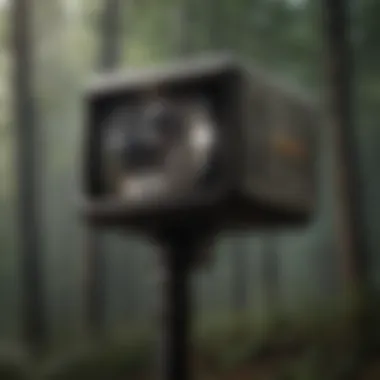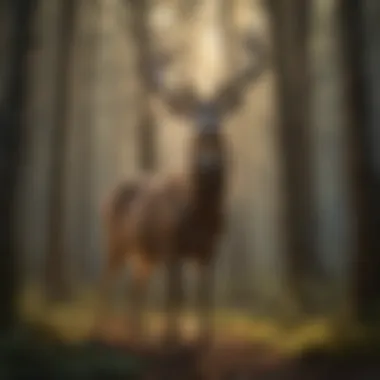Understanding Motion Sensor Strobe Lights for Deer Deterrence


Intro
Deer can pose significant challenges for homeowners, particularly when it comes to maintaining gardens and landscaping. Understanding the factors that attract deer and the potential solutions to mitigate their presence is essential. One innovative approach involves the use of motion sensor strobe lights, which can effectively deter these creatures while minimizing harm to the environment. This article delves into the principles behind motion detection technology and explores how strobe lights function as a deterrent.
Additionally, we will examine installation best practices and operational considerations necessary for maximizing their effectiveness. Homeowners, gardeners, and pest control professionals will benefit from the insights and strategies presented here, equipping them with the knowledge needed to confront deer-related challenges.
Pest Identification
Before employing deterrents, it is important to identify common pests, particularly deer, and understand their behaviors.
Detailed descriptions of common pests
White-tailed deer are the most common species found in suburban and rural areas across North America. These animals are usually recognizable by their large ears, short tails, and distinctive white underbellies. They tend to be most active during dawn and dusk, making these times critical for monitoring potential interactions with gardens and yards.
Signs and symptoms of infestations
The signs of deer presence can include:
- Chewed or damaged plants, especially tender leaves and flowers.
- Droppings found near feeding areas; these are typically small and pellet-shaped.
- Trampled ground, usually visible near densely vegetated areas.
- Scrapes or rubs on tree trunks; deer mark their territory this way.
Deterrent Strategies
Once you have identified that deer are a concern, it is crucial to implement effective deterrent strategies.
Home maintenance tips for pest prevention
To reduce the likelihood of attracting deer, homeowners can take several practical steps:
- Trim plants that may be particularly palatable to deer.
- Secure garbage in containers with tight-fitting lids to avoid attracting wildlife.
- Install fencing around gardens, using materials that are tall and sturdy. This may reduce chances of deer access.
Natural deterrents and barriers
Several natural solutions can create barriers or make gardens less appealing:
- Use strong-smelling plants, such as marigolds or lavender, to mask appetizing scents of fruits and vegetables.
- Apply predator urine or commercial deer repellents around garden borders.
Treatment Options
If deterrents alone are ineffective, other treatment options may be considered.
Overview of chemical vs. natural treatments
Chemical treatments may include commercial repellents that are specifically designed for deer. However, natural treatments often have the additional benefit of being environmentally friendly and posing less risk to other wildlife. Both methods have pros and cons, and effectiveness can depend on various factors including weather and deer behavior.
Step-by-step guides for DIY treatments
Creating natural treatments can be simple. Homeowners can make a homemade deer repellent using ingredients found around the home:
- Mix four eggs with one quart of water and one tablespoon of hot sauce.
- Blend until the mixture is smooth.
- Strain the mixture to remove solids.
- Apply to plants by spraying, taking care to reapply after weather events.
Understanding the specific behaviors and habits of deer is crucial for effectively managing their impact on your property.
In summary, the integration of motion sensor strobe lights provides an innovative approach for managing deer populations. By gaining insights into pest identification, employing effective deterrent strategies, and exploring treatment options, homeowners can significantly reduce the risks associated with deer activity.
Preamble to Motion Sensor Strobe Lights
The significance of using motion sensor strobe lights to deter deer cannot be overlooked. As property owners increasingly seek effective pest management methods, understanding the technology behind these lights is crucial. Motion sensor strobe lights serve as a non-invasive approach to protecting landscapes and gardens from deer damage. The integration of advanced motion detection technology with strobe light effects provides a unique solution that not only shields gardens but also promotes a safer environment for local wildlife.
Definition and Functionality
Motion sensor strobe lights are devices designed to detect movement within a specific area and, upon detection, emit a bright, flashing light. Their primary purpose is to startle animals, including deer, preventing them from approaching certain areas. Typically, these lights are paired with motion detectors that utilize infrared sensors or radar technology to identify movement. The sudden burst of light acts as a deterrent, exploiting the animal's inherent fear response.
Types of Motion Sensor Strobe Lights
Different types of motion sensor strobe lights can be selected based on specific needs and conditions. Knowing the distinct features can help homeowners choose the right system for their property.
Solar-powered options
Solar-powered motion sensor strobe lights capture energy from sunlight and convert it into electricity to power the device. This option is particularly beneficial as it promotes sustainability and reduces energy costs. The key characteristic of solar-powered units is their independence from wiring, making installation easy and hassle-free. One of the unique features is their ability to operate during the day while storing energy for night use. However, the performance might vary based on sunlight exposure. This variability may lead to limitations during cloudy or winter months.
Wired vs. wireless
Wired motion sensor strobe lights are directly connected to an electrical supply, ensuring consistent power. Their enduring nature is a significant advantage, suitable for permanent setups that require reliability. In contrast, wireless models benefit from easy installation as they do not need any physical connections. The flexibility of wireless systems allows homeowners to relocate them with ease. One downside to wired systems is the complexity involved in installation, which may require professional assistance. Wireless options, while convenient, can face issues with battery life or signal interference, impacting performance over time.
Portable vs. permanent installations
Portable motion sensor strobe lights offer flexibility, allowing users to place them in various locations as needed. They are particularly useful for homeowners who frequently change their garden layout or those who wish to target specific areas periodically. Their ease of use is a highlight, making them favored for temporary uses. On the other hand, permanent installations ensure continuous protection in high-risk areas. The primary trade-off involves the commitment to a fixed position, which may limit adaptability. Proper assessment of the property can guide the choice between portable and permanent installations.


Deer Behavior and Deterrence Methods
Understanding deer behavior is vital when it comes to effective deterrence methods. Deer are creatures of habit, often following specific patterns in their daily lives. By gaining insight into their habits, individuals can make informed decisions on employing deterrents like motion sensor strobe lights. This section discusses the key aspects of deer behavior—feeding patterns, breeding habits, and territorial behavior—highlighting how these elements inform effective deterrence strategies.
Understanding Deer Habits
Feeding patterns
Feeding patterns of deer are dictated by various seasonal and environmental factors. They usually graze in the early morning and late afternoon. This timing makes them more susceptible to deterrent methods during these peak hours. By knowing when deer are most active, homeowners can optimize the operation of their strobe lights.
A key characteristic of feeding patterns is that deer are attracted to specific food sources. Moreover, areas with lush vegetation are often hotspots for grazing. Therefore, placing strobe lights near these feeding areas helps deter deer more effectively. However, the challenge is that deer may eventually become accustomed to the lights if they are consistently present. Thus, regular adjustments in light positioning may be necessary.
Breeding habits
Breeding habits of deer influence their movement and behavior significantly during certain times of the year. The mating season, known as the rut, typically occurs in late fall. During this period, deer become more aggressive in their search for mates, often traveling farther from their usual feeding grounds. This change in behavior can make them more vulnerable to deterrent methods.
The unique feature of breeding habits is that they alter deer dynamics temporarily but can lead to increased populations in the long term. Therefore, understanding when the rut occurs is beneficial in planning the timing for strobe light activation. However, this method may not be as effective if deer migrate to new areas during the breeding season.
Territorial behavior
Territorial behavior is another aspect that affects how deer react to their environment. Male deer can become quite defensive of their territory, especially during the mating season. They will mark their territory through scent markings and visual cues. This behavior makes them more sensitive to disturbances in their environment, including unusual light sources.
A highlight of territorial behavior is that it showcases deer as cautious creatures. When they detect movement or the blinking of strobe lights, their instinct is often to retreat. Therefore, strategically placing lights in known territorial areas can amplify the effectiveness of deterrence. However, there is also a risk that deer may become habituated to the strobe lights. This could lessen their effectiveness over time.
Traditional Deterrence Techniques
Fencing solutions
Fencing solutions provide a physical barrier to deter deer. They can be quite effective depending on the type used. Ideally, fencing needs to be tall enough, typically at least eight feet, to prevent deer from jumping over. This characteristic makes fencing a reliable method for stopping deer if there is no other means of entry.
One downside of fencing is the initial cost and potential maintenance challenges. Constructing and installing a solid fence can require a significant investment in time and resources. Homeowners must weigh the long-term benefits against the upfront costs and effort required.
Repellent sprays
Repellent sprays are another traditional method to keep deer away. They are designed to produce odors that are unappealing to deer. The key feature of these sprays is their ease of application. They can be sprayed directly onto plants or surrounding areas without requiring extensive setup.
However, repellent sprays may need regular reapplication, especially after rain. This requires consistent effort to maintain their efficacy. Additionally, some sprays can have variable effectiveness, depending on deer populations in the area.
Natural predators
Introducing natural predators into an environment is another deterrence strategy. This method relies on the instinctual fear deer have for wolves or coyotes. The presence of these predators can discourage deer from frequenting certain areas.
However, this approach may not be practical for all homeowners. The introduction of predators can create ecological imbalance or raise concerns for pet safety. Additionally, the effectiveness may vary depending on the local environmental context.
It is important to consider various deer behavior aspects when deciding on a deterrence method. A detailed understanding allows for a more targeted approach, increasing the chances of successful deer management.
How Motion Sensor Strobe Lights Work
Understanding how motion sensor strobe lights function is critical to their use in deterring deer. These systems utilize various technologies to sense motion and trigger a bright flash of light, creating an environment that is unsettling for deer. The effectiveness of these lights goes beyond mere illumination; they exploit the natural behaviors of wildlife. The deployment of these lights can significantly reduce deer intrusion in gardens and yards, providing a practical solution for homeowners concerned about potential damage.
Mechanics of Motion Detection
Infrared sensors
Infrared sensors play a pivotal role in the functionality of motion sensor strobe lights. They detect changes in heat emitted by objects in their vicinity. The key characteristic of infrared sensors is their sensitivity to heat, making them a popular choice for outdoor security devices.
One unique feature of infrared sensors is their ability to distinguish between living creatures and inanimate objects. This capability is advantageous in minimizing false alarms, ensuring that only deer or other animals trigger the lights. However, one disadvantage is that extreme weather conditions can affect their sensitivity, leading to reliability issues during heavy rain or snow.
Radar technology
Radar technology represents another innovative approach in motion detection. It emits radio waves that bounce off objects and return to the sensor. The key benefit of radar technology is its ability to detect motion over longer distances compared to infrared sensors. This characteristic makes radar a valuable option for larger properties.
A unique feature of radar technology is its capability to function effectively in various environmental conditions, including rain and fog. However, it may be costlier than traditional systems, potentially discouraging homeowners from adoption.
Photoelectric sensors
Photoelectric sensors utilize beams of light to detect motion. If an object, such as a deer, interrupts the light beam, the sensor activates the strobe light. The key advantage of photoelectric sensors is their quick response time, which provides instant feedback when deer approach.
A unique feature of these sensors is their versatility in installation, allowing placement in many settings. However, they can be more susceptible to triggering from non-target animals, which can lead to increased operational costs and annoyance for homeowners.
Strobe Light Technology
LED vs. traditional bulbs
The choice between LED and traditional bulbs has significant implications for motion sensor strobe lights. LED lights are known for their energy efficiency and durability, offering a longer lifespan compared to traditional incandescent bulbs. This characteristic helps in reducing long-term costs for homeowners.
The unique feature of LEDs is their ability to produce bright light with low energy consumption. This aspect makes them a beneficial option in areas where electricity may be limited. However, LEDs can sometimes lack the warm light quality that traditional bulbs offer, which may not appeal to all homeowners interested in aesthetics.


Light intensity and frequency
Light intensity and frequency are crucial parameters when considering the effectiveness of strobe lights. High-intensity flashes can startle deer more effectively than dimmer lights. The key characteristic of frequency refers to how rapidly the light flashes; a faster frequency can cause heightened alertness among deer, contributing to their deterrence.
A unique feature of adjustable intensity and frequency settings in strobe lights is the ability for homeowners to customize the system to their specific environment. Nonetheless, improper settings may result in nuisance lighting in surrounding areas or reduced deterrent effects.
Color temperature and wavelength effects
Color temperature and wavelength can influence the perception of strobe lights by deer. Higher color temperatures usually appear more bluish and are associated with daylight, which can be unsettling for deer. The key characteristic here is that different wavelengths can result in varied visibility effects and responses from wildlife.
A unique feature of strobe lights utilizing mixed wavelengths is the potential enhancement of their effectiveness, as certain wavelengths can be more disruptive than others. The downside, however, is that not all strobe lights provide adjustable color settings, which can limit options for homeowners aiming to optimize effectiveness.
Psychological Effects of Strobe Lights on Deer
The psychological effects of strobe lights on deer play a significant role in pest deterrence strategies. Understanding how these animals react to sudden illumination can help property owners implement effective methods to safeguard their gardens and landscapes. By leveraging the natural instincts of deer, one can craft a more tailored approach that maximizes the efficacy of motion sensor strobe lights while minimizing harm to wildlife.
Fear Responses in Deer
Fear is a basic instinct that dictates the behavior of many animals, including deer. Understanding the nuances of fear responses is essential to developing effective deterrents.
Flight responses
Flight responses in deer refer to their instinctual reaction to flee from perceived threats. This particular behavior manifests rapidly when a deer encounters startling stimuli, such as a sudden burst of light. The principal characteristic of flight responses is their immediacy; deer can react almost instantaneously to danger. This makes flight responses a beneficial element for the deterrence goal outlined in this article.
The unique feature of flight responses is their direct correlation to the survival mechanisms of deer. They run away from disturbances, which can effectively keep them away from gardens or agricultural areas. However, there is a downside; frequent exposure to strobe lights may lead to altered behavior patterns, prompting the animals to adapt.
Stress behavior
Stress behavior in deer is a critical factor as it encompasses the physiological and psychological effects that accompany fear. When deer experience stress, their behavior may alter significantly, influencing their feeding and breeding habits. This characteristic is notable as it raises the visibility of the deterrent's effectiveness.
A unique aspect of stress behavior is that it can lead to long-term changes in deer populations. While initially beneficial for protection, this stress can have unintended consequences, such as diminished reproductive success. Thus, while inducing stress can be effective in the short term, its long-term implications must be considered.
Long-term habituation
Long-term habituation involves deer becoming accustomed to strobe lights over time. This phenomenon occurs when the animals repeatedly encounter the stimulus without negative consequences. The key characteristic of long-term habituation is that it eventually reduces the effectiveness of the deterrent. As deer become desensitized, they may ignore the strobe lights altogether.
This unique feature has significant implications for strategy development. While strobe lights can have a profound effect initially, their ability to deter deer may diminish with continued use. Hence, home and landowners should consider rotating deterrent methods or incorporating varying light patterns to maintain their effectiveness.
Comparative Analysis with Other Deterrents
When discussing deterrents, it's essential to evaluate their effectiveness holistically. Comparing motion sensor strobe lights with other methods can yield insights into the best practices for deer management.
Effectiveness of noise vs. light
The effectiveness of noise compared to light can vary based on environmental conditions and deer's behavioral traits. Noise deterrents can attract attention but may lack the immediate impact that sudden light brings. A key characteristic of this comparison is the element of surprise that light offers, which is often more responsive than noise. While strobe lights can produce a quick reaction from deer, excessive noise can lead to stress without immediate escape behavior.
However, the disadvantage of using noise is that it may intrude on the peace of residential areas, causing concern among homeowners.
Behavioral conditioning
Behavioral conditioning emphasizes the concept where deer can learn from their experiences, becoming either acutely aware or indifferent to certain stimuli. Motion sensor lights exploit this by creating associations in the minds of the deer. The key characteristic here is its educational nature; deer will learn to associate the bright strobe lights with danger, prompting avoidance.
This conditioning has both advantages and disadvantages. While it effectively keeps deer away, the process may require time and consistent exposure, which may not be feasible for homeowners seeking immediate results.
Visual stimuli in deer communication
Visual stimuli play a crucial role in deer communication, significantly influencing their behavior and social interactions. The brightness and suddenness of strobe lights present unique cues that can either deter or confuse deer. This characteristic highlights the adaptability of deer to visual stimuli. While light can instigate alarm, it can also evoke curiosity or confusion, complicating its deterrent effectiveness.
This duality can lead to varied responses depending on the determination of the deer. The advantage of implementing a strong visual stimulus is its ability to reach animals over considerable distances, effectively making landowners aware of deer presence before any damage occurs.
Installation of Motion Sensor Strobe Lights
The installation of motion sensor strobe lights is crucial in maximizing their effectiveness in deterring deer from gardens and properties. Proper installation not only enhances performance but also ensures safety and compliance with local regulations. By focusing on strategic placement and thorough preparation, homeowners can significantly increase their chances of a successful deterrence strategy.
Best Placement Strategies
Height and angle considerations
When installing motion sensor strobe lights, height and angle are fundamental factors. Positioning the lights at an optimal height, around six to eight feet, provides the best detection range. It allows the sensors to pick up the movement of animals effectively while minimizing the chances of false triggers from smaller animals. The angle also plays a critical role; lighting should face toward areas with previous deer activity. This strategy increases the likelihood of activation while covering larger ground. Therefore, understanding these characteristics is essential in creating a well-thought-out installation plan, reducing errors, and ensuring the system operates at peak efficiency.
Effective coverage areas
Defining effective coverage areas for motion sensor strobe lights is another vital consideration. Identifying spots where deer tend to frequent, such as entry points to gardens or forests, informs better placement decisions. The lights should be installed to cover these spots comprehensively, leaving no blind spots. High-quality units can often illuminate up to 100 feet, depending on the specifications. This not only maximizes deterrence but also helps to create an unfavorable environment for deer. However, it is important to regularly assess the surrounding landscape, as vegetation or structural changes might affect the light coverage.
Testing light responsiveness
After the installation, checking the light responsiveness is key. This involves walking within the sensor's range to ensure the lights activate as intended. Such testing can reveal issues like sensor misalignment or inadequate sensitivity settings. Fine-tuning the sensitivity can help prevent unnecessary activations due to wind or small animals. By confirming the system's operational effectiveness, homeowners can maximize the technology's benefits and minimize disruption. Regular testing also keeps the installation aligned with fluctuating deer behavior, providing ongoing effectiveness.


Safety Considerations
Compliance with local regulations
Adhering to local regulations is paramount when installing motion sensor strobe lights. Certain areas may have laws governing the brightness of outdoor lighting or specific usage guidelines for pest deterrents. Check local guidelines to avoid potential fines or complaints from neighbors. Compliance not only ensures legal safety but also fosters amicable community relationships. Always review local documents or consult municipal resources to stay informed about relevant regulations that impact the installation.
Wiring and weatherproofing
Essential wiring and adequate weatherproofing are integral to ensuring a reliable installation that can withstand various environmental conditions. Poorly done wiring may lead to malfunctions or safety hazards such as short circuits. Utilizing weatherproof fixtures helps protect against rain, snow, and other elements. This choice increases the longevity of the equipment while contributing to operational reliability. Investing in quality components can make a significant difference in maintaining an effective deer deterrent solution, minimizing the need for frequent replacements and repairs.
Maintenance protocols
Establishing maintenance protocols is crucial for ongoing effectiveness after installation. Regularly checking the system for dirt or obstructions can prevent malfunctions. This routine should also include inspecting the light bulbs or strobe units for functionality. Even minor issues, like a burnt-out bulb, can deter the entire deterrent system. Keeping a maintenance log provides a detailed overview of checks performed and replaces required components. This systematic approach ensures a proactive stance on maintenance, leading to sustained effectiveness and reduced disruption in deer deterrence efforts.
Evaluating Effectiveness
Evaluating the effectiveness of motion sensor strobe lights is crucial in understanding their role in deer deterrence. It is not just about installation but also about monitoring, adjusting, and refining strategies based on actual results. This section emphasizes the need for a detailed assessment of how well these devices function in real scenarios. By analyzing effectiveness, homeowners can ensure they are making the most of their investment and improving their approaches to managing deer-related issues.
Monitoring Deer Activity
Camera integration for data collection
Integrating camera systems for data collection is a key component in evaluating the effectiveness of motion sensor strobe lights. Cameras capture real-time activity patterns and document changes in deer behavior after the strobe lights are installed. This allows homeowners to visually assess the impact of the light deterrents.
One significant characteristic of camera integration is its ability to provide reliable data over time. The information gathered helps to establish a clear before-and-after picture, indicating whether the deterrent is successful. However, cameras can be expensive and may require additional setup. Thus, homeowners should weigh the costs against the benefits before deciding on this approach.
Comparative analysis pre- and post-installation
Comparative analysis before and after installation is vital for understanding how effective motion sensor strobe lights are. This method involves gathering data on deer presence in the area prior to the lights being set up and then measuring any changes in deer activity afterward. A strong point of this analysis is that it directly correlates results to interventions, offering a clear picture of effectiveness. This approach allows homeowners to quantify the success of their efforts. An important unique feature of comparative analysis is the ability to track specific patterns and trends over time. This method is straightforward to implement but requires diligent data collection practices, which can sometimes be time-consuming.
Refining strategies based on observations
Refining strategies based on observations is integral to optimizing deer deterrence methods. After monitoring and analyzing the collected data, homeowners can modify their approaches to maximize the effectiveness of motion sensor strobe lights. Adjustments might include repositioning lights or combining them with other deterrents. A key characteristic of this method is its adaptability. As situations change, strategies can evolve based on what works best. A notable advantage is that it allows for a more tailored approach to pest management. However, any refinements should be based on comprehensive data to ensure they are made on solid evidence.
Limitations and Challenges
Potential habituation effects
Potential habituation effects present a significant challenge when using motion sensor strobe lights. Over time, deer may become accustomed to the strobe lights, diminishing their effectiveness. This is an important consideration since continued reliance on the same method without evaluation can lead to unsatisfactory results.
A notable characteristic of habituation is that it can vary between deer populations. Some may adapt quickly while others may not. This variability means homeowners need to be vigilant and prepared to adjust their strategies if habituation begins to compromise deterrence.
Environmental factors influencing performance
Environmental factors can significantly influence the performance of motion sensor strobe lights. Factors such as weather conditions, seasonality, and surrounding vegetation can affect both the visibility and impact of the strobe lights. For example, heavy rain or fog can reduce light visibility. One key point is that these conditions should be considered when installing and relying on these devices. Homeowners may need to evaluate performance continually based on external conditions. Such assessments might reveal the need for adjustments to enhance effectiveness during variable environmental conditions.
Variability in deer populations
Variability in deer populations stands as another crucial factor to consider in evaluating effectiveness. Different areas may have varying deer densities, behaviors, and responses to deterrents. Understanding local deer populations can help tailor strategies adequately.
An important characteristic of this variability is that it reflects the general ecosystem health. It allows for more precise applications of pest management practices. However, effectively understanding these populations requires awareness and monitoring of local wildlife. This complexity may complicate efforts, especially in areas with fluctuating deer numbers.
Integration with Other Deer Management Strategies
Understanding motion sensor strobe lights in isolation offers only part of the solution for effective deer deterrence. The integration of these lights with other management strategies enhances their effectiveness, allowing for a more holistic approach towards managing deer populations. Such integration not only broadens the scope of deterrence methods but also helps address various environmental and behavioral factors that influence deer activity. By employing various techniques concurrently, homeowners and pest control professionals can produce better results while also minimizing the risk of deer habituation, which can occur when a single technique is relied upon too heavily.
Holistic Management Approaches
Implementing a combination of methods creates a more formidable barrier against deer. Each tactic can reinforce the others, leading to a more significant impact on the deer themselves.
Combining visual and olfactory deterrents
The concept of combining visual and olfactory deterrents stems from a basic understanding of how deer interact with their environment. When motion sensor strobe lights are used along with scents that deer find unpleasant, it significantly raises the chance of deterring them effectively. The key characteristic of this method is its multifaceted approach, targeting both visual and scent-based responses in deer. This dual strategy is a beneficial choice for homeowners aiming to safeguard their gardens and crops from deer damage. The unique feature of combining these deterrents ensures that even if deer become somewhat accustomed to one type of deterrent, the other method still provokes an adverse reaction. However, one should consider the potential for olfactory deterrents to affect other wildlife if not used responsibly.
Seasonal adjustments in strategies
Another essential aspect is seasonal adjustments in strategies. Deer behavior varies significantly across seasons due to changes in food availability, breeding cycles, and migration patterns. Adjusting deterrent methods to align with these seasonal variations is crucial for maintaining effectiveness. This adaptability is a popular choice for homeowners looking to maintain a responsive deer management plan year-round. The unique feature of this approach lies in its emphasis on observation—understanding when deer are most active allows for targeted deterrence. By reevaluating and adjusting strategies based on seasonal shifts, homeowners can prevent deer from associating a specific deterrent with quiet periods, thus avoiding easy habituation.
Community collaboration for broader impact
Community collaboration represents a crucial aspect of a comprehensive deer management strategy. When multiple households engage in coordinated efforts, the impact can be remarkably amplified. The key characteristic of this approach is its focus on shared resources and information, leading to more efficient deer deterrence practices. For community members, this collaborative environment can lead to a shared understanding of deer behavior and common problem-solving strategies. A unique feature is the pooling of data and experiences that can help refine practices over time. However, the challenge here lies in effectively organizing and maintaining communication among participants, as inconsistent participation may reduce effectiveness.
Future Directions in Deterrence Technologies
As we look forward, the realm of deterrence technologies continues to evolve, offering new possibilities in managing deer populations. Integrating these innovations with traditional methods could significantly influence pest management in the future.
Innovation in sensing technologies
Emerging technologies are focused on enhancing the precision and effectiveness of motion sensors. New innovations aim to reduce false alarms and to detect deer more accurately, which can have a profound impact on overall deterrence strategies. The key characteristic of these advancements lies in their ability to adapt to a variety of environmental conditions. This makes them a beneficial addition for homeowners concerned with both efficiency and reliability. The unique feature of innovative sensing technologies is their potential to integrate with smart home systems, allowing for real-time monitoring and adjustment of deterrence measures. However, these systems often come at a higher cost and may require technical expertise for installation and maintenance.
Data-driven pest management practices
Data-driven approaches leverage analytics to assess deer activity patterns and effectiveness of deterrents. Utilizing technology to gather and analyze data leads to more informed decisions about when and where to deploy deterrents. The key characteristic of data-driven methodologies is their reliance on empirical evidence rather than guesswork. This approach is favorable for those looking to optimize their pest management strategy continuously. A unique feature of these practices is the use of mobile applications for easy tracking and adjustments. The downside may be the initial learning curve for some homeowners unfamiliar with data analytics.
Ethical considerations in wildlife management
Finally, ethical considerations must be brought into account when developing and implementing deterrence strategies. As techniques become more advanced, it is crucial to evaluate their impact on deer populations and their habitats. This aspect is vital for ensuring responsible pest management without causing undue harm to local ecosystems. The key characteristic of ethical considerations is their focus on sustainable practices. Incorporating ethical guidelines is a beneficial choice to promote community trust and long-term effectiveness. The unique feature of this approach emphasizes the importance of finding a balance between effective deterrence and respect for wildlife. However, navigating ethical dilemmas can complicate decision-making for homeowners, as it often requires compromises.
Effective deer management requires a combination of strategies that can adapt over time to changing conditions and community dynamics. Integrating new technologies while remaining ethically responsible enhances both deterrence effectiveness and ecological sustainability.



